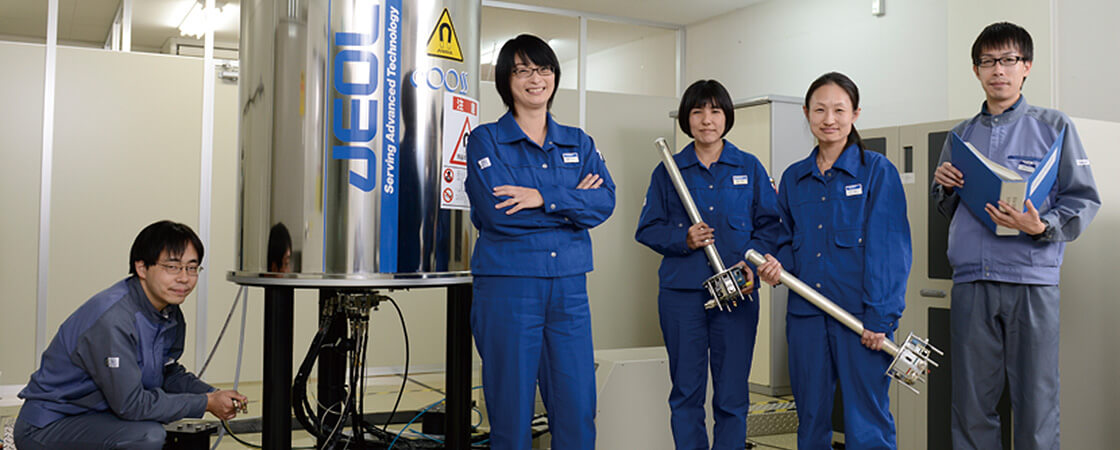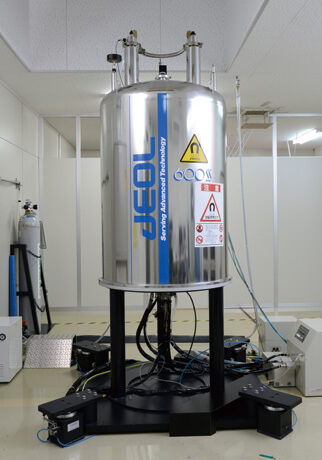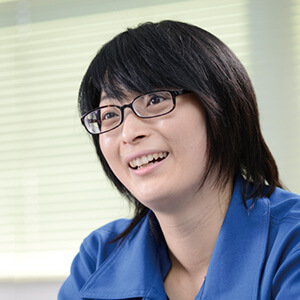The Future of Material Engineering Revealed by Solid-state NMR, the Guardian Angel of Manufacturing

INTERVIEW 03
Yoko Sakiyama Senior Researcher
2nd Material Science Laboratory Material Science Laboratories
Toray Research Center, Inc.
LED, fuel cells, diamond-like carbon…
Japan continues to produce outstanding products using world-leadingmanufacturing technology. The application technology of the analytic chemists of TRC with their JEOL solid state NMR are opening new horizons.
Japanese Companies Focusing on Analysis
” Japanese companies really put a high priority on analysis," says Yoko Sakiyama of the Toray Research Center, Inc. (TRC). She is the leader of the laboratory that includes the group responsible for the nuclear magnetic resonance equipment (NMR).
The Toray Research Center, Inc. (TRC) is an independent analysis and research company, receiving requests from businesses and universities, and performing the analysis, assessment and research tasks related to R&D and production. TRC was established as a separate entity in 1978 by Toray Industries, Inc. as a spinoff of their research department, making it one of the oldest independent spinoff companies in the field of consigned analysis.
As a result of this long history, they have particular expertise in the analysis of polymers and macromolecules, covering a wide range of fields, including semiconductors, displays, printers, batteries, energy, automotive, industrial materials, environment, medicine, and biotechnology.
It is often the case that analysis requests are made after some trouble has occurred, and the client wants to clarify the cause. Nevertheless, where TRC truly shows its ability is in the role of a partner during the research and development stage.
“Clients often consult us when they have created something good. Instead of just saying ‘That’s great!’, they want to find out why they got the good result, and to verify the mechanisms and structure. We have worked on many projects over a long period of time, starting from the initial R&D stage.”
Solid-State NMR to Measure Insoluble Substances

JEOL Solid-state NMR used in Structural Chemistry Lab 2
In NMR there are systems designed to handle liquid samples (liquid-state NMR) and systems designed to handle solid samples (solid-state NMR). The solid-state NMR frequently used at TRC is an instrument capable of obtaining structural information of a whole substance at the molecular level. For most substances, if it can be dissolved, it will be easier to analyze as a solution. This is because there is a wider range of analysis techniques for liquids, and the information is easy to acquire. However, some polymers are difficult to dissolve in solvents. It is not uncommon for the properties of the material to change when dissolved, such as pharmaceutical products, or the structural information to become averaged. This is where solid NMR plays an important role.
For example, the analysis of lithium ion batteries is one of the requests often received by Ms. Sakiyama. The clients come for help with problems like faster than expected degradation, so the battery no longer charges and discharges, or to learn more about a new material and why it offers good performance.
Within the electrodes of a lithium ion battery, the lithium exists as ordinary lithium ions or in compounds. As the material degrades, however, some portions that receive electrons become metallic lithium, creating a dangerous form of lithium that is highly reactive. Only solid-state NMR makes it possible to determine whether the analyte is a lithium compound or metallic lithium. Solid-state NMR is also a useful tool for quantitative analysis, to determine what percentage of the material has degraded.
Offering the Optimal Analysis Menu through YOKOGUSHI (Company-wide) Collaboration
However, the causes of the deterioration of lithium ion batteries cannot be identified by NMR alone. Various analysis methods must be combined to determine where the deterioration is progressing in the anode, cathode and separator materials. To achieve this, at TRC, multiple groups each specializing in a different method collaborate on a company-wide scale to provide the ideal menu of analysis options.
Additionally, since there is a danger that the lithium will ignite violently if the battery is exposed to the atmosphere, the measurements and the disassembly must be performed without any atmospheric exposure. The samples are usually brought to TRC as battery packs, and the special team at TRC performs the disassembly and extraction of the target materials to ensure that analyses are conducted safely.
Beyond merely performing analysis, they find the cause of the deterioration and propose ways to prevent deterioration for the development stage. The role played by TRC in improving the level of manufacturing in Japan is not small.
Support for Advanced Manufacturing
One of the things that TRC has been working on a lot recently is diamond-like carbon. This material can be deposited as a smooth and diamond-hard film on surfaces of semiconductor materials, machine tools or engine pistons to dramatically enhance the properties of the part. The range of its application is expanding rapidly.
The characteristics of this material are determined by the composition ratio of 2 kinds of carbon having different structures. Solid carbon can be sp2 carbon, which is a conductor, or sp3 carbon, which is an insulator. The greater the amount of sp2, the closer the material will be to graphite. As the amount of sp3 increases, the material becomes more like a diamond. The optimal proportions are determined depending on the desired application.
The ability to differentiate the structural differences of carbon, and to verify the amount of each type that is present is something that only solid-state NMR offers. Ms. Sakiyama and her team are receiving more and more requests related to the selection of this kind of material, with clients asking “It looks very good, but what is the actual compound ratio?”
Another area in which even more requests has grown is fuel cells. Fuel cell vehicles finally became commercially available in November 2014. In anticipation of a significant market expansion, material makers, battery makers, as well as automobile manufacturers are rushing to be the first in line for consultation and analysis. Electrolytic polymers are an important component of fuel cells, but are not easily dissolved. This is the situation that calls for the solid-state NMR.
“You’d like the battery installed in your car to last for 10 years. The first polymers really did deteriorate severely, and were not suitable for practical use. Part of the reason that fuel cell cars have finally appeared in the market is the improved durability of the polymers and catalysts, as well as the establishment of the technology to apply the catalyst coatings uniformly. For those of us who have continued to evaluate these materials for more than 10 years, it is a truly significant achievement.”
Opening New Horizons with the 1 mm Probe
The mainstay of the work by Sakiyama and her team is a JEOL solid state NMR.
“Of course the instrument performance is important, but we also appreciate being able to consult with JEOL about a certain kind of measurement we’d like to make, and receiving valuable suggestions and improvements in return almost immediately. It is really gratifying to see the interest and effort JEOL gives to our inquiries. Since it is a machine, there are times it doesn’t work perfectly, but we always receive quick service support.”
In 2012 a probe (detector) was added to enable the use of ultra-fine sample tubes with a diameter of 1 mm. This made it possible to overcome a problem that had plagued NMR for some time, the need for large quantities of a sample. The ability to make measurements with small sample amounts vastly expanded the range of analysis targets.
For example, TRC had received many requests to figure out why LED brightness was deteriorating. The amount of material used in an LED is quite small, however, making measurements with NMR difficult. With the introduction of the 1 mm probe, it is now possible to add investigation of LED deterioration to their list of services.
“In many cases, the deterioration is only on the surface of the material, or only in a localized area. Thanks to the 1 mm probe, it is possible to take shavings and analyze only the portion you want to see. This is a huge step forward for us.”
For the future, TRC would like to focus more on medical materials, such as the polymers used in dialysis, and green chemistry, an area utilizing the cellulose and lignin contained in plants as a raw material.
“For the new fields, since the analysis methodologies have not been established, we hope to collaborate with Universities, etc. to develop a variety of assessment and evaluation methods.”
The efforts of the analytic chemists with NMR seem to hold the key to showing us a new world.

Yoko Sakiyama
Senior Researcher
2nd Material Science Laboratory Material Science Laboratories
Toray Research Center, Inc.
Received a Masters Degree from Osaka University of Engineering Science in Synthetic Chemistry in 1999.
Joined Toray Research Center, Inc. the same year. Subsequently assigned to the Structural Analysis Group, where she continues to be active. Current research areas are analyses using solid state NMR.
Analysis subjects include fuel cells, lithium batteries, capacitors, polymers, pharmaceutical products, and inorganic catalysts.
Posted:April 2015
